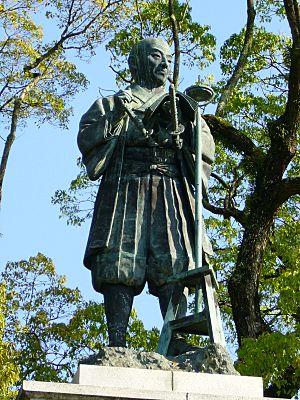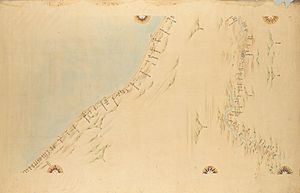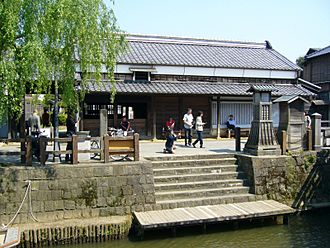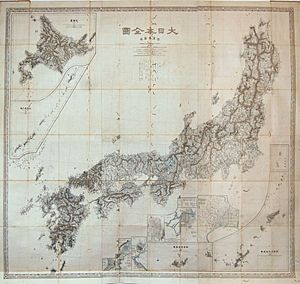Inō Tadataka facts for kids
Quick facts for kids
Inō Tadataka
伊能 忠敬 |
|
|---|---|

Statue of Inō Tadataka in Katori City
|
|
| Born | February 11, 1745 Kujūkuri, Chiba, Japan
|
| Died | May 17, 1818 (aged 73) |
| Nationality | Japanese |
Inō Tadataka (伊能 忠敬, February 11, 1745 - May 17, 1818) was a famous Japanese surveyor and mapmaker. He is best known for creating the very first accurate map of Japan. He used new and modern surveying methods to do this.
Contents
Early Life of Inō Tadataka
Inō was born in a small village called Ozeki. This village was located on Kujūkuri beach in Kazusa Province. Today, this area is part of Chiba Prefecture. His childhood name was Sanjirō.
When Inō was seven, his mother passed away. At age 17, he was adopted by the wealthy Inō family. They lived in Sawara, which is now a part of Katori, Chiba. He took over their family business. He helped it grow by expanding their sake brewing and rice-trading. He managed the business until he was 49 years old.
After retiring, Inō moved to Edo (which is now Tokyo). There, he became a student of astronomer Takahashi Yoshitoki. From Takahashi, Inō learned about Western astronomy, geography, and mathematics.
Mapping Japan: Inō's Big Project

In 1800, after almost five years of studying, the Tokugawa shogunate (Japan's military government) gave Inō permission to survey the country. He had to pay for this work himself at first. This huge task took up the rest of his life, about 17 years.
Inō mapped the entire coastline of Japan. He also surveyed some parts of the land inside each of the Japanese home islands. During this time, Inō spent 3,736 days making measurements. He traveled an amazing 34,913 kilometers (about 21,694 miles)! He regularly stopped to show the Shōgun (the military ruler) the maps he had made.
He created very detailed maps of certain areas, especially in Kyūshū and Hokkaidō. Some of these maps were at a scale of 1:36,000, meaning one unit on the map represented 36,000 units in real life. Others were at 1:216,000.
Inō's greatest work, his 1:216,000 map of Japan's entire coastline, was not finished when he died in 1818. However, his team of surveyors completed it in 1821. An atlas (a book of maps) with all his survey work was published that same year. It was called Dai Nihon Enkai Yochi Zenzu (Maps of Japan's Coastal Area).
This atlas included three large-scale maps at 1:432,000. It showed the whole country on eight pages at 1:216,000. It also had 214 pages of very detailed coastal areas at 1:36,000. Inō's maps, known as Inō-zu, were incredibly accurate. They were the best maps of Japan for almost 100 years. Maps based on his work were still used as late as 1924.
Inō's Survey Expeditions
Inō completed his surveys in ten different expeditions. The first survey began on June 11, 1800. It included five members. This survey mainly focused on mapping the coast of Hokkaidō. Russian ships had been coming there to trade.
This first survey was done mostly by measuring walking steps. They also used astronomical observations (looking at stars and planets). They traveled to Bekkai in far northeast Hokkaido. In total, they walked and surveyed 3,244 kilometers (about 2,016 miles).
Inō paid for almost all of the first survey himself. The results helped the shogunal government understand how important his work was. Because of this, Inō received more support starting with his second expedition. This expedition left Edo in the summer of 1801. It was much more ambitious. It covered most of the eastern coast of Japan, from just south of Edo to the northern tip of Honshū. Then they surveyed the inland part on their way back. This expedition lasted about six months and covered 3,122 kilometers (about 1,940 miles).
After the second survey, people trusted Inō's project more and more. By the fifth expedition, 19 people were involved. They covered almost 7,000 kilometers (about 4,350 miles). On the eighth expedition, they covered over 13,000 kilometers (about 8,078 miles) in 914 days. Most of this was in Kyūshū. By this time, Inō was 70 years old, which was much older than the average lifespan back then.
Besides his maps, Inō also wrote scholarly works about surveying and mathematics. These included Chikyū sokuenjutsu mondō and Kyūkatsuen hassenhō.
Remembering Inō Tadataka
In November 1995, the Japanese government released a special 80 yen postage stamp. It showed Inō's picture and a part of his map of Edo.
Most of the complete copies of Inō's atlas have been lost or destroyed, often by fire. However, a nearly complete copy of the large-scale map was found in the U.S. Library of Congress in 2001.
After his death, Inō was one of 37 people honored at the Hokkaidō Shrine. He was honored as a kami (a god or spirit). This was because of his important work in helping the Japanese government explore and develop Hokkaidō.
Inō Tadataka's grave is located at the Genkū-ji temple in Taitō-ku, Tokyo. His grave was named a National Historic Site in 1928.
Inō Tadataka Former Residence
| Inō Tadataka Former Residence | |
|---|---|
|
伊能忠敬旧宅
|
|

Inō Tadataka Former Residence
|
|
| General information | |
| Town or city | Katori, Chiba |
| Country | Japan |
| Coordinates | 35°53′17″N 140°29′53″E / 35.88806°N 140.49806°E |
| Completed | 1793 |
Inō's old home in Sawara is still standing today. It is located on the bank of the Ono River in Katori City. This house was named a National Historic Site in 1930. The building was built during the Edo period. It includes a gate, the main house, an attached kitchen, a library, and a kura warehouse. All the buildings have tiled roofs. The main building has five rooms.
The Inō family was one of the most important families in Sawara. Inō lived in this location from when he was adopted at age 17 in 1762. He stayed there until he retired and moved to Edo at age 50. However, the building you see today was built in 1793. At that time, Inō was 48 years old. So, he only lived in this exact building for two years. This building used to be the Inō Tadataka Memorial Museum (伊能忠敬記念館, Inō Tadataka Kinenkan). But the museum has now moved to a new building across the street.


